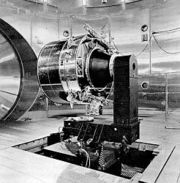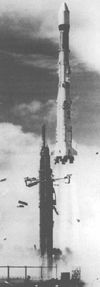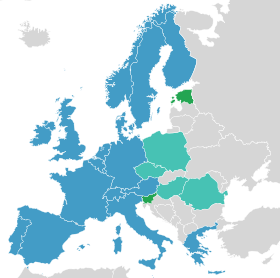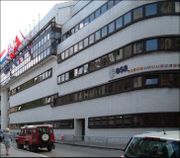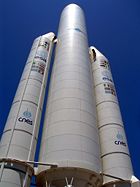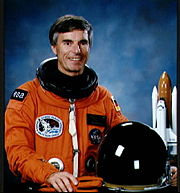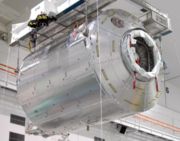European Space Agency
2008/9 Schools Wikipedia Selection. Related subjects: Space transport
 |
|
| Owner |
17 European states
|
|---|---|
| Established | 1975 |
| Headquarters | Paris, France |
| Primary spaceport | Guiana Space Centre |
| Administrator | Jean-Jacques Dordain |
| Budget | €2.9 ($4.260) bn (2007) |
| Official language(s) | None, de facto English, French and German |
| Website | www.esa.int |
The European Space Agency (ESA), established in 1975, is an intergovernmental organisation dedicated to the exploration of space, currently with 17 member states. Headquartered in Paris, ESA has a staff of close to 2,000 with an annual budget of about €2.9 billion in 2007.
ESA's main spaceport is the Guiana Space Centre in Kourou, a site made available by France. It is close to the equator, hence commercially important orbits are easier to access. ESA became the market leader in commercial space launches in the 1990s. In recent years, ESA has also established itself as a major player in space exploration.
ESA science missions are based at ESTEC in Noordwijk, Netherlands, Earth Observation missions at ESRIN in Frascati, Italy, ESA Mission Control ( ESOC) is in Darmstadt, Germany, and the European Astronaut Centre ( EAC), that trains astronauts for future missions is situated in Cologne, Germany.
History
Foundation
After the Second World War, many European scientists had left Western Europe in order to work either in the US or the Soviet Union. Although the 1950s boom made it possible for Western European countries to invest in research and specifically in space related activities, Western European scientists realised solely national projects would not be able to compete with the two main superpowers. In 1958, only months after the Sputnik shock, Edoardo Amaldi and Pierre Auger, two prominent members of the western European scientific community at that time, met to discuss the foundation of a common western European space agency. The meeting was attended by scientific representatives from eight countries, including Harrie Massey (UK).
The Western European nations decided to have two different agencies, one concerned with developing a launch system ELDO (European Launch Development Organisation) and the precursor of the European Space Agency, and ESRO (European Space Research Organisation) that was established on March 20, 1964 by an agreement signed on June 14, 1962. From 1968 to 1972, ESRO celebrated its first successes. Seven research satellites were brought into orbit, all by US launch systems.
ESRO's successor organisation ESTEC (European Space Research and Technology Centre, based in Noordwijk, the Netherlands) is still a part of ESA, though ESA itself is a much bigger organisation today. ESA in its current form was founded in 1975, when ESRO was merged with ELDO. ESA had 10 founding members: Belgium, Germany, Denmark, France, United Kingdom, Italy, the Netherlands, Sweden, Switzerland and Spain. ESA launched its first major scientific mission in 1975, Cos-B, a space probe monitoring gamma-ray emissions in the universe.
End of space race
Beginning in the 1970s, when the space race between the US and the Soviet Union had cooled down and space budgets were cut dramatically in both superpowers, ESA established itself as a forerunner in space exploration. ESA joined NASA and the UK in the IUE, the world's first high-orbit telescope, which was launched in 1978 and operated very successfully for 18 years. A number of successful Earth-orbit projects followed, and in 1986 ESA began Giotto, its first deep-space mission, to study the Comets Halley and Grigg-Skejllerup. Hipparcos, a star-mapping mission, was launched in 1989 and in the 1990s SOHO, Ulysses and the Hubble Space Telescope were all jointly carried out with NASA. Recent scientific missions in cooperation with NASA include the Cassini-Huygens space probe, to which ESA contributed by building the Titan landing module Huygens.
As the successor of ELDO, ESA has also constructed rockets for unmanned scientific and commercial payloads. Ariane 1, launched in 1979, brought mostly commercial payloads into orbit from 1984 onward. The next two developments of the Ariane rocket were intermediate stages in the development of a more advanced launch system, the Ariane 4, which operated between 1988 and 2003 and established ESA as the world leader in commercial space launches in the 1990s. Its successor, the Ariane 5 rocket, has established itself within the heavily competitive commercial space launch market after its first flight which ended in failure in 1997 and prospectively will reach 25 successful launches by 2006.
The beginning of the new millennium saw ESA become, along with agencies like NASA, JAXA, and Roscosmos, one of the major participants in scientific space research. While ESA had relied on cooperation with NASA in previous decades, especially the 1990s, changed circumstances (such as tough legal restrictions on information sharing by the United States military) led to decisions to rely more on itself and on cooperation with Russia. A recent press issue thus stated:
Russia is ESA's first partner in its efforts to ensure long-term access to space. There is a framework agreement between ESA and the government of the Russian Federation on cooperation and partnership in the exploration and use of outer space for peaceful purposes, and cooperation is already under way in two different areas of launcher activity that will bring benefits to both partners.
Most notable for its new self-confidence are ESA's own recent successful missions Smart-1, a probe testing cutting-edge new space propulsion technology, the Mars Express mission as well as the development of the Ariane 5 rocket.
ESA maintains its scientific and research projects mainly for astronomy-space missions such as Corot, launched on 27 December 2006, a milestone in the search for extrasolar planets.
Goals and aims
Mission
Since the Cold War ended with the fall of the Soviet Union's "iron curtain," space agencies around the world had to refocus and revise their visions and goals. In an interview with JAXA, the Japanese national space agency, Jean-Jacques Dordain ESA's Director General (since 2003) outlined briefly the European Space Agency's mission:
| “ | Today space activities are pursued for the benefit of citizens, and citizens are asking for a better quality of life on earth. They want greater security and economic wealth, but they also want to pursue their dreams, to increase their knowledge, and they want younger people to be attracted to the pursuit of science and technology. I think that space can do all of this: it can produce a higher quality of life, better security, more economic wealth, and also fulfil our citizens' dreams and thirst for knowledge, and attract the young generation. This is the reason space exploration is an integral part of overall space activities. It has always been so, and it will be even more important in the future. |
” |
|
|
||
ESA has ambitious space plans that may be divided into three broad categories. First, ESA will maintain its scientific and research projects (e.g. tests and developments of new propulsion systems), try to find ways to reduce costs for its rocket fleet while enhancing its capacities, honour its commitments regarding the ISS and engage in further space exploration like the Venus Express mission that was launched in late 2005. The second category has many parallels to NASA's plans and consists of astronomy-space missions such as the Planck Surveyor studying the cosmic microwave background (2008), the Herschel space observatory (2008), and the Darwin interferometer.
While the projects described above are more or less similar in their structure and aim as NASA's and other space agencies' plans, the ESA's Mars project is different. The Aurora Programme lays out a time table for future missions to Mars, however in contrast to NASA's plans there is no emphasis on manned or unmanned lunar missions, it rather includes several flagship missions designed to develop and test technology needed for a manned European Mars mission currently planned for 2030. Among these flagship missions is ExoMars, a mission involving a Mars rover. Until 2005 ExoMars was planned to be a joint mission between NASA and ESA, however obstacles such as American technology law that prohibits sharing of classified space technology information led to ESA deciding to go for it alone. The mission is currently planned to launch in 2013. An even more ambitious Mars project is the Mars Sample Return Mission, that is planned as a follow-up mission to ExoMars. It will involve the first time a probe will return of samples from another planet, making it necessary to construct an ascent module that is capable of starting into Mars orbit and dock with the original probe.
Among the actions for returning the investment to society, they have developed the SCOS 2000 satellite control centre, and they allow the use of it free of charge to any European firm.
To increase the human value of the participating countries, ESA also develops collaborative training programmes for students, young graduates and Post Doctorals. Some countries have their own bilateral agreements with ESA like the Portuguese trainees or the Spanish Trainees programmes. The return of the trainees to their respective country aims to stimulate their national space industry.
In October 2007, ESA announced candidate projects for Cosmic Vision 2015-2025, blueprint of the future scientiific program, including Laplace Jupiter probe, Tandem Saturn/Titan/Enceladus probe, Cross-Scale near-Earth space environment study, Marco Polo asteroid sample return mission, Dune and SPACE dark-energy study, Plato new planet finder, SPICA infrared telescope, and XEUS X-ray telescope.
Member countries and structure
ESA comprises the national space organisations and other entities of seventeen countries that participate to varying degrees in the mandatory (23% of total expenditures or €667 million in 2005) and optional space programs (72% of total expenditures or €2138 million in 2005):
According to the Resolution 8, Annex 1, of the Convention for the establishment of the European Space Agency. all meetings of the agency are held in English, French and German, with translation provided in these three languages. All official documents are available in English and French with all documents concerning the ESA-Council being available in German, as well.
Enlargement
Nations who want to become a full member of ESA do so in three stages. First a Cooperation Agreement is signed between the country and ESA. In this stage the country has very limited financial responsibilities. If a country wants to cooperate more fully with ESA it signs a European Cooperating State (ECS) Agreement. The ECS agreement makes companies based in the country eligible for participation in ESA procurements. The country can also participate in all ESA programmes, except for the Basic Technology Research Programme. While the financial contribution of the country concerned increases, it is still much lower that that of a full member state (see below). The agreement is normally followed by a Plan for European Cooperating states (or PECS Charter). This is a five year program of basic research and development activities aimed at improving the nations' space industry capacity. At the end of the five year period the country can either begin negotiatons to become a full member state or sign a new PECS Charter. ESA is likely to expand quite rapidly in the coming years. Many countries which joined the EU in both 2004 and 2007 have started to cooperate with ESA on various levels:
- The Czech Republic is set to become a full member of ESA by the end of 2008. Full membership has been approved by the ESA governing council but still awaits Czech parliamentary ratification. The Czech Republic has been an ECS state since 24 November 2003. It signed the PECS Charter 24 November 2004.
- Hungary has been an ECS state since April 2003. It signed the PECS Charter on 5 November 2003.
- Romania has been an ECS state since 17 February. 2006, It signed the PECS Charter on 16 February 2007.
- Poland has been an ECS state since 27 April 2007. It signed the PECS Charter on 26 April 2008.
- Estonia signed a Cooperation Agreement with ESA on 26 June 2007.
- Slovenia signed a Cooperation Agreement with ESA on 27 May 2008.
Budget
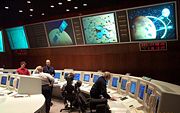
The budget of ESA was announced as €2.977 billion for 2005 (a ten percent increase on 2004) and for 2006 is estimated at €2.904 billion. A large part of ESA's budget is invested in ESA's launch vehicles that are currently the most expensive part of ESA's activities (Twenty-two percent of the budget goes into launch vehicles; human space flight is second in budget expenditures). In 2005, the three largest contributors, together funding two thirds of ESA's budget, are France (29.3%), Germany (22.7%) and Italy (14.2%).
An important ministerial conference approved nearly all of ESA's budget requests in December 2005. The budget for the mandatory ESA programme, parts of the optional programme (i.e. optional for ESA's member states such as the ISS involvement) as well as important projects such as Aurora or the EU-backed Galileo navigation system have been approved. No decision has been reached with regard to ESA's involvement in the Russian Kliper project, a feasibility study worth €50 million was not approved. ESA's budget will stay at about the same, however inflation-adjusted, level as 2005 throughout the next 5 years.
| Member country | Mandatory Contr. |
Optional Contr. |
Total (€ mill.) |
Total (%) |
|---|---|---|---|---|
| 15.63% | 31.55% | 778.8 | 27.97% | |
| 23.41% | 21.45% | 614.8 | 22.08% | |
| 12.88% | 14.59% | 397.9 | 14.29% | |
| 16.93% | 5.91% | 239.3 | 8.59% | |
| 2.83% | 7.37% | 167.4 | 6.34% | |
| 6.87% | 5.76% | 169.0 | 6.07% | |
| 3.40% | 3.49% | 97.3 | 3.49% | |
| 4.43% | 2.87% | 90.9 | 3.26% | |
| 2.61% | 2.11% | 62.5 | 2.25% | |
| 2.26% | 0.87% | 33.7 | 1.21% | |
| 1.70% | 1.02% | 33.2 | 1.19% | |
| 1.82% | 0.78% | 28.8 | 1.03% | |
| 1.37% | 0.54% | 20.7 | 0.74% | |
| 0.95% | 0.30% | 12.8 | 0.46% | |
| 1.40% | 0.21% | 12.7 | 0.45% | |
| 1.50% | 0.12% | 12.5 | 0.43% | |
| 0.21% | 0.13% | 4.2 | 0.15% |
- Note that 5% of ESA's budget comes from third party sources. E.g. Canada.
Locations
- Headquarters of ESA, Paris, France
- European Space Operations Centre (ESOC), Darmstadt, Germany
- Centre Spatial Guyanais, Kourou, French Guiana
- European Space Research and Technology Centre (ESTEC), Noordwijk, The Netherlands
- ESA Centre for Earth Observation (ESRIN), Frascati, Italy
- European Astronaut Centre (EAC), Cologne, Germany
- European Space Astronomy Centre ( ESAC), Madrid, Spain.
- ESTRACK European Space Tracking Network
Launch vehicle fleet
ESA has made great progress towards its goal of having a complete fleet of launch vehicles in service, competing in all sectors of the launch market. ESA's fleet will soon consist of three major rocket designs, Ariane 5, Soyuz and Vega. Rocket launches are carried out by Arianespace, a CNES subsidiary (a minority share is held by EADS as well), at CNES's spaceport in French Guiana. Because many communication satellites have equatorial orbits, launches from French Guiana are able to take larger payloads into space than from other northern spaceports. In addition, equatorial launches give spacecrafts an extra 'push' of nearly 500 m/s due to the higher rotation velocity of someone standing on the equator than near the Earth's axis where rotation velocity approaches nil.
Ariane 5
The Ariane 5 rocket is the primary launcher of the ESA. Its maximum estimated payload is 6–10 metric tons to GTO and up to 21 metric tons to LEO. The launch craft has been in service since 1997 and replaced the Ariane 4. The Ariane rocket exists in several specifications, the heaviest one of these is the Ariane 5 ECA that failed during its first test flight in 2002, but has since made fifteen consecutive successful flights.
ESA's Ariane 1, 2, 3 and 4 launchers (the latter of which was ESA's long time workhorse) have been retired.
Soyuz launch vehicle
Soyuz is a Russian medium payload (ca. 3 metric tons to GTO) launcher to be brought into ESA service in 2007. ESA has entered into a €340 million joint venture with the Russian Federal Space Agency over the use of the Soyuz launcher. Under the agreement, the Russian agency will manufacture Soyuz rocket parts for ESA, which will then be shipped to French Guiana for assembly. ESA benefits because it gains a medium payloads launcher, complementing its fleet while saving on development costs. In addition, the Soyuz rocket—which has been the Russian's space launch workhorse for some 40 years—is proven technology with a good safety record, which ESA might be happy to use for launching humans into space.
Russia also benefits in that it will get access to the Kourou launch site. Launching from Kourou rather than Baikonur will allow the Russians to almost double the Soyuz payload (3.0 tonnes vs. 1.7 tonnes), because of Kourou's closer proximity to the equator. Both agencies benefit from the long term strategic cooperation that in addition will be used to jointly develop future technology. It is perhaps worth noting that France (ESA's largest contributor) has historically had good relations with Russia, which contributed to reaching the agreement.
Vega
Vega is ESA's small payload (ca. 1.5 metric tons to 700 km orbit) launcher; its first launch is planned for 2008. The leading ESA's member state for the Vega Programme is Italy contributing 65% of the costs. Vega itself has been designed to be a body launcher with three solid propulsion stages and an additional liquid propulsion upper module to place the cargo into the exact orbit intended. For a small-cargo rocket it is remarkable that Vega will be able to place multiple payloads into orbit. Its first and main stage (P80) is a direct modification of Ariane 5 EAP (Solid boosters) developed by the CNES, the French space agency.
Human space flight
History
At the time ESA was formed, its main goals did not encompass human space flight, rather it considered itself to be primarily a scientific research organisation for unmanned space exploration in contrast to its American and Soviet counterparts. It is therefore not surprising that the first non-Soviet European in space was not an ESA astronaut on a European space craft: It was Czechoslovak Vladimir Remek who in 1978 became the first non-Soviet European in space (the first European in space being Yuri Gagarin of the Soviet Union) — on a Soviet Soyuz spacecraft, followed by the Pole Mirosław Hermaszewski and East German Sigmund Jähn in the same year. This Soviet cooperation programme, known as Intercosmos, primarily involved the participation of Eastern bloc countries, however in 1982, Jean-Loup Chrétien became the first western European on a flight to the Soviet Salyut 7 space station.
Because Chrétien did not officially fly into space as an ESA astronaut, but rather as a member of the French CNES astronaut corps, the German Ulf Merbold is considered the first ESA astronaut to fly into space. He participated in the STS-9 Space Shuttle mission that included the first use of the European built Spacelab in 1983. STS-9 marked the beginning of an extensive ESA/NASA joint partnership that included dozens of space flights of ESA astronauts in the following years. Beside paying for seats on the Space Shuttle, ESA continued its human space flight cooperation with the Soviet Union and later Russia, including numerous visits to Mir.
During the latter half of the 1980s, European human space flights changed from being the exception to routine and therefore, in 1990, the European Astronaut Centre in Cologne, Germany was established. It selects and trains prospective astronauts and is responsible for the coordination with international partners especially with regards to the International Space Station. As of 2006, the ESA astronaut corps officially includes 12 members, including nationals from all the large Western European countries except the United Kingdom.
On April 3, 2008, ESA director general Jean-Jacques Dordain announced that recruiting for a new class of European astronauts will start in the near future.
Astronaut Corps
The astronauts of the European Space Agency are:
|
|
- ¹ retired now
- ² have visited Mir
- ³ have visited the International Space Station
- ² have visited Mir
Manned launch vehicles
In the 1980s France pressed for an independent European manned launch vehicle. Around 1978 it was decided to pursue a reusable spacecraft model and starting in November 1987 a project to create a mini-shuttle by the name of Hermes was introduced. The craft itself was modelled comparable to the first proposals of the Space Shuttle and consisted of a small reusable spaceship that would carry 3 to 5 astronauts and 3 to 4 metric tons of payload for scientific experiments. With a total maximum weight of 21 metric tons it would have been launched on the Ariane 5 rocket, which was being developed at that time. It was planned solely for use in Low-Earth orbit space flights. The planning and pre-development phase concluded in 1991; however, the production phase was never fully implemented because at that time the political landscape had changed significantly. With the fall of the Soviet Union ESA looked forward to cooperation with Russia to build a next-generation human space vehicle. Thus the Hermes program was cancelled in 1995 after about 3 billion dollars had been spent.
In the 21st century ESA started new programs in order to create its own manned spacecraft, most notable among its various projects and proposals is Hopper, whose prototype by EADS, called Phoenix, has already been tested. While projects such as Hopper are neither concrete nor to be realised within the next decade, other possibilities for human spaceflight in cooperation with the Russian Space Agency have emerged. Following talks with the Russian Space Agency in 2004 and June 2005, a cooperation between ESA and the Russian Space Agency was announced to jointly work on the Russian-designed Kliper, a reusable spacecraft that would be available for space travel beyond mere LEO (e.g. the moon or even Mars). It was speculated that Europe would finance part of it. However, a €50 million participation study for Kliper, which was expected to be approved in December 2005, was finally not approved by the ESA member states. The Russian state tender for the Kliper project was subsequently cancelled in the summer of 2006.
In June 2006 ESA member states granted 15 million to the Crew Space Transportation System (CSTS) study, a two-year study to design a spacecraft capable of going beyond Low-Earth orbit based on the current Soyuz design. This project is pursued with Roskosmos instead of the previously cancelled Kliper proposal. A decision on the actual implementation and construction of the CSTS spacecraft is contemplated for 2008, with the major design decisions being made before the summer of 2007.
Cooperation with other organisations
European Union
ESA is not an agency or body of the European Union (EU), and has non-EU countries such as Switzerland and Norway as members. There are however ties between the two, with various agreements in place and being worked on, to define the legal status of ESA with regard to the EU. There are common goals between ESA and the EU, and ESA has an EU liaison office in Brussels. On certain projects, the EU and ESA cooperate, such as the upcoming Galileo sattelite navigation system. The EU's new Treaty of Lisbon would makes space policy an area for voting in the European Council. This might lead to a more united stance on space policy, and strengthen ties between the EU and ESA.
National space organisations of member countries
- The Centre National d'Études Spatiales (CNES) (National Centre for Space Study) is the French government space agency (administratively, a "public establishment of industrial and commercial character"). Its headquarters are in central Paris. CNES is the main participant on the Ariane project. Indeed CNES designed and tested all Ariane family rockets (mainly from its centre in Evry near Paris)
- The British National Space Centre (BNSC) is a partnership of the UK government departments which are active in space. Through the BNSC the partners provide delegates to represent the UK on the various ESA governing bodies. Each partner funds its own programme.
- The Italian Space Agency (Agenzia Spaziale Italiana or ASI) was founded in 1988 to promote, coordinate and conduct space activities in Italy. Operating under the Ministry of the Universities and of Scientific and Technological Research, the agency cooperates with numerous entities active in space technology and with the president of the Council of Ministers. Internationally, the ASI provides Italy's delegation to the Council of the European Space Agency and to its subordinate bodies.
- The German Aerospace Centre (DLR) (German: Deutsches Zentrum für Luft- und Raumfahrt e. V.) is the national research centre for aviation and space flight of the Federal Republic of Germany and of other member states in the Helmholtz Association. Its extensive research and development projects are included in national and international cooperative programmes. In addition to its research projects, the centre is the assigned space agency of Germany bestowing headquarters of German space flight activities and its associates.
- The Instituto Nacional de Técnica Aeroespacial (INTA) (Spanish:National Technical Institute for Aerospace) is the spacial agency for Spain.
Canada
Since January 1, 1979, Canada has had the special status of a Cooperating State within ESA. By virtue of this accord, the Canadian Space Agency takes part in ESA's deliberative bodies and decision-making and also in ESA's programmes and activities. Canadian firms can bid for and receive contracts to work on programmes. The accord has a provision ensuring a fair industrial return to Canada.
Russia
ESA has entered into a major joint venture with Russia in the form of the CSTS.
China
Since China has started to invest more money into space activities, the Chinese Space Agency has sought international partnerships. ESA is, beside the Russian Space Agency, one of its most important partners. Recently the two space agencies cooperated in the development of the Double Star Mission.
International Space Station
With regard to the International Space Station (ISS) ESA is not represented by all of its member states: 5 of the 17 countries have opted out either because of concerns about the expense of the project or lack of interest. ESA is taking part in the construction and operation of the ISS with contributions such as Columbus, a science laboratory module that was brought into orbit by NASA's STS-122 Space Shuttle mission and the Cupola observatory module that was completed in July 2005 by Alenia Spazio for ESA. The current estimates for the ISS are approaching €100 billion in total (development, construction and 10 years of maintaining the station) of which ESA has committed to paying €8 billion. About 90% of the costs of ESA's ISS share will be contributed by Germany (41%), France (28%) and Italy (20%). German ESA astronaut Thomas Reiter was the first long-term ISS crew member.
As of 2008, the spacecraft establishing supply links to the ISS are the Progress, Soyuz and Space Shuttle. ESA has developed the Automated Transfer Vehicle (ATV) for ISS resupply. Each ATV has a cargo capacity of 7,667 kilograms (16,900 lb). The first ATV, Jules Verne, was launched on 9 March 2008 and on 3 April 2008 successfully docked with the ISS. This manoeuvre, considered a major technical feat, involved using automated systems to allow the ATV to track the ISS, moving at 27,000km/h, and attach itself with an accuracy of 2 cm. No other spacefaring nations or space agencies currently possess this automatic rendezvous and docking capability, considered key to future space exploration. With the Space Shuttle reaching its retirement age in 2010, until NASA has a replacement for it such as COTS (the CEV is not expected to make its first operational manned flight before 2012) the ATV together with Progress, Soyuz and the Japanese transporter HTV (which will be ready in 2009) will be the only links between Earth and the ISS.
